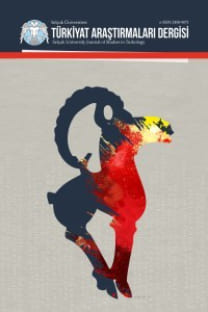Muğla-Yatağan İlçesi Eskihisar’da Türk Dönemi Eserleri
Bu makalede Muğla İli Yağan İlçesi Eskihisar’da yer alan Türk dönemine ait eserler ele alınmıştır. Günümüze kadar sürekli yerleşim gören Eskihisar, Stratonikeia Antik Kentiyle iç içe geçmiş, Beylikler döneminden Cumhuriyet dönemine kadar devamlılık gösteren eserleri izleyebildiğimiz önemli bir yerleşmedir. Özellikle Bizans döneminden sonra Türkler tarafından iskân edilmeye başlanan Eskihisar’da Selçuklu hamam geleneğinde yapılmış küçük ölçekli bir köy hamamı bulunmaktadır. Plan ve yapım teknikleri bakımından 14-15 yy. yapısı olduğu görülmektedir. M. 1876 tarihinde Şaban Ağa tarafından yaptırılan kare bir harime sahip ve revaklı bir son cemaat yeri olan cami geç dönem Osmanlı yapılarından birisidir. Bu caminin etrafında oluşturulan köy meydanında da mesleklerin icra edildiği ticaret yapıları yer almaktadır. Bu çalışmada daha çok geç dönem Osmanlı ve Erken Cumhuriyet dönemine ait sivil mimarlık örnekleri ele alınmıştır. Geleneksel Muğla evleri özelliklerine sahip bu yapılar genellikle iki katlı, kırma çatılı ve bir avlu içerisinde yer alan oldukça sade yapılardır. Makaleye dâhil ettiğimiz bu eserler hamam, cami, ticaret yapıları ve çok sayıda sivil mimarlık örneği çalışmamızın esasını oluşturmaktadır. İncelenen eserler; mimarlık ve sanat tarihi açısından ele alınarak bütün özellikleriyle kentin Antik dönemden günümüze gelişen kent dokusu ortaya konmaya çalışılmıştır.
Anahtar Kelimeler:
Eskihisar, Hamam, Cami, Ticaret Yapısı, Ev
Turkish Period Monuments in Eskihisar, Muğla-Yatağan District
In this article, the monuments of Turkish period in Eskişehir Yatağan District of Muğla Province are discussed. Eskihisar, which has been inhabited continuously till today, is an important settlement where we can watch the works that are intertwined with the Ancient City of Stratonikeia and that have continued from the period of Anatolian Turkish Principalities to the Republic period. There is a small-scale village bath built in the tradition of Seljuk baths in Eskihisar, which started to be settled by the Turks especially after the Byzantine period. It is understood to be a 14th-15th century building in terms of plan and construction techniques. The mosque, which was built by Şaban Ağa in 1876, has a square harim (sanctuary) with a portico courtyard, is one of the late Ottoman structures. There are trade buildings where some professions are carried out in the village square built around this mosque. In this study, the examples of civil architecture of the late Ottoman and Early Republic periods are examined. These buildings, which have the characteristics of traditional Muğla houses, are generally two-floored, hipped roofed and quite simple structures located in a courtyard. These monuments, which are included in the article, constitute the basis of our work, including Turkish baths, mosques, trade buildings and many examples of civil architecture. The monuments, which are examined, has been handled in terms of architecture and art history, and by that it has been tried to reveal the texture, which has been developed from the ancient period to the present, of the city.
Keywords:
Eskihisar, Turkish Bath, Mosque, Trade Building, House,
- ISSN: 1300-5766
- Yayın Aralığı: Yılda 3 Sayı
- Başlangıç: 1994
- Yayıncı: Selçuk Üniversitesi
Sayıdaki Diğer Makaleler
Sümerbank Ereğli Pamuklu Dokuma Fabrikası (1934-1997)
22 Numaralı Anadolu Ayniyat Defterine Göre Anadolu Eyaletinin Merkez-Taşra İlişkileri
Geç Dönem Çağatay Türkçesinde Nasreddin Hoca Fıkraları
Oğuzhan KARABURGU, Fatih ERBAY
Kumluca (Antalya) Ağzından Derleme Sözlüğü’ne Katkılar
Gazneli Mahmûd'un Halife El-Kâdir Billâh'a Mektubuna Göre Horasan’ın Gazneliler Tarafından Fethi
Dilbilgisel Kanıtsallık İşaretleyicilerinin Sözlükselleşmesi: Özbek Türkçesinde mish-mish(lar)
